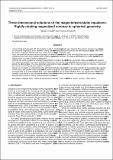Three-dimensional solutions of the magnetohydrostatic equations : rigidly rotating magnetized coronae in spherical geometry
Abstract
Context. Magnetohydrostatic (MHS) equilibria are often used to model astrophysical plasmas, for example, planetary magnetospheres or coronae of magnetized stars. However, finding realistic three-dimensional solutions to the MHS equations is difficult, with only a few known analytical solutions and even finding numerical solution is far from easy. Aims. We extend the results of a previous paper on three-dimensional solutions of the MHS equations around rigidly rotating massive cylinders to the much more realistic case of rigidly rotating massive spheres. An obvious application is to model the closed field line regions of the coronae of rapidly rotating stars. Methods. We used a number of simplifying assumptions to reduce the MHS equations to a single elliptic partial differential equation for a pseudo-potential U, from which all physical quantities, such as the magnetic field, the plasma pressure, and the density, can be derived by differentiation. The most important assumptions made are stationarity in the co-rotating frame of reference, a particular form for the current density, and neglect of outflows. Results. In this paper we demonstrate that standard methods can be used to find numerical solutions to the fundamental equation of the theory. We present three simple different cases of magnetic field boundary conditions on the surface of the central sphere, corresponding to an aligned dipole field, a non-aligned dipole field, and a displaced dipole field. Our results show that it should be possible in the future to use this method without dramatically increasing the demands on computational resources to improve upon potential field models of rotating magnetospheres and coronae.
Citation
Al-Salti , N & Neukirch , T 2010 , ' Three-dimensional solutions of the magnetohydrostatic equations : rigidly rotating magnetized coronae in spherical geometry ' , Astronomy & Astrophysics , vol. 520 , A75 . https://doi.org/10.1051/0004-6361/201014887
Publication
Astronomy & Astrophysics
Status
Peer reviewed
ISSN
0004-6361Type
Journal article
Collections
Items in the St Andrews Research Repository are protected by copyright, with all rights reserved, unless otherwise indicated.

